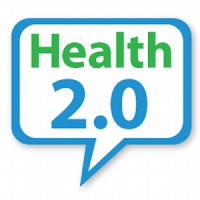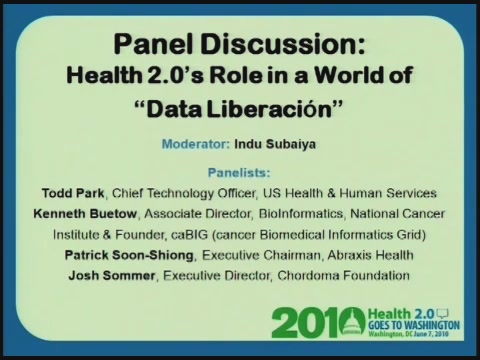 The Health 2.0 Conference convened its first meeting in Washington, DC, today, with public sector health leaders and private sector innovators coming together in a Great Big Kumbayah. This conference featured two prominent and key players absent from previous Health 2.0 Conferences: patients on every panel, and the Federal government punctuating the start, the middle, and the end of the day’s agenda.
The Health 2.0 Conference convened its first meeting in Washington, DC, today, with public sector health leaders and private sector innovators coming together in a Great Big Kumbayah. This conference featured two prominent and key players absent from previous Health 2.0 Conferences: patients on every panel, and the Federal government punctuating the start, the middle, and the end of the day’s agenda.
The over-arching message: Data Liberación! says Todd Park, the DHHS Technology Officer. This follows last week’s launch by DHHS of the Community Health Data Initiative (which Park wants to rename with your help here). [More about the CHDI herefrom Health Populi] The point of freeing the data, which has been virtually locked in Federal and State government silos, is for people, providers and researchers to mash-it-up, learn, and apply to improve health outcomes. In this regard, Linda Harris, lead of the Health Communication and eHealth Team at the Office of Disease Prevention and Health Promotion in DHHS, pointed to the Healthy People 2020 goals. When data liquidity comes to health care, all Americans have the prospect of better health status in 2020 than we do have in 2010.
Will Yu, innovations guru in the Office of the National Center for Health IT (ONCHIT, SHARP team) kicked off the day with an inspiring mantra on the need for innovation in health. This was followed by a number of innovative application demos, always a key feature at Health 2.0 conferences. Among them, I’m especially intrigued by ScanAvert which helps users “Shop Healthier, Be Healthier” with a mobile scan technology linking barcodes to food safety recall data and ingredient substitute information for dietary restrictions and allergies. This mobile application fits into the new health paradigm of participatory health for engaged people who want to make smart microdecisions throughout the day recognizing that health is a 24×7 pursuit, largely happening outside of the doctor’s office and health system.
 The panel I led on consumer adoption of health IT featured three very smart actors on the health policy and technology scene, and a fourth passionate patient advocate: Carol Diamond of The Markle Foundation, Linda Harris of DHHS, Gordon Norman of Alere, and for the patient perspective, the irrepressible and non-stoppable Trisha Torrey whose new book, You Bet Your Life, gets a consistent five star rating on Amazon.
The panel I led on consumer adoption of health IT featured three very smart actors on the health policy and technology scene, and a fourth passionate patient advocate: Carol Diamond of The Markle Foundation, Linda Harris of DHHS, Gordon Norman of Alere, and for the patient perspective, the irrepressible and non-stoppable Trisha Torrey whose new book, You Bet Your Life, gets a consistent five star rating on Amazon.
Among this group’s wisdom-sharing was Diamond’s mention of Markle’s objective to get consumers their health records simply downloaded. This could do more for consumers’ meaningful use than many other more complicated transactions being offered in responses to MU.
On the patient front, this Conference featured numerous, passionate people who shared personal stories and offered challenges to the Health 2.0 and government communities. Each panel had a patient featured, and an additional panel led by Gilles Frydman, Founder of ACOR, consisted of only patients six of them, recounting their stories through a 2.0 lens. I cannot favorite one of the six, as I was moved and actively note-taking during all of them, learning new twists on Health 2.0 through the most valuable lens of all that of patients who experienced their “moment” when they decided to become very active participants in their own care (more on the “Moment,” below)
Another feature at this meeting were announcements for competitions and challenges. Perhaps it’s the influence of the XPrize or our love of The Biggest Loser, but peoples’ competitive spirits are rising. Among the announcements: $80 million for a VA innovation initiative; and, the Health 2.0 Developer Challenge, which was announced at the CHDI meeting on June 2 2010, and re-announced at this Conference.
Another, different sort of challenge was made by Gilles Frydman: a competition for patients to create personal videos telling their stories of when they experience “the moment” when they decided to become fully engaged in their own health care, or the care fora loved one. Videos will be posted to YouTube, and the finalist will be professionally reshot. Stay tuned for more details on this provocative challenge. The Moment site can be found here.
Health Populi’s Hot Points: More gauntlets were thrown down by several speakers, both patients and organizations. Jon Kuniholm of the Open Prosthetics Project is challenging the Federal Government to break down the silos between the (at least) eight Federal agencies involved in research, development and funding for prosthetic innovation. He graphically noted the progression of the telephone, from Graham Bell’s innovation to the iPhone compared to the evolution of the prosthetic arm, which basically appears the same since its original designs from the 19th century.
Jamie Heywood, Founder of Patients Like Me, responded to various Federal government speakers’ statements that they’re looking for the private sector to lead innovation in health care. Heywood argued for the opposite for the Federal government to show some steely grit and show leadership in reimagining the health system. Just because entrepreneurs can create useful apps with newly-freed health data does not a health system re-make, he asserted – and I agree. Since the Federal government is morphing into the predominant payer for health in the U.S., payer-power can move a market.
Indu Subaiya and Matthew Holt, Co-Founders of the Health 2.0 Conference, introduced the session by saying that there were about 30 companies in the so-called Health 2.0 space when they brainstormed the conference just a few years ago. Today, they count in their evolving database at least 1,000 organizations that do something related to Health 2.0.
That’s tremendous growth in numbers. Clearly, both patients and healthy human citizens are feeling more empowered when entering a doctor’s exam room with pre-researched information on symptoms and conditions, protesting an insurance denial for an expensive drug, and finding community in an online social network for HIV/AIDS, depression, cancer, and virtually every known condition identified in the ICD-10.
But to Jamie Heywood’s point, Health 2.0 cannot be a panacea for a nation’s broken health system. When we heard at the meeting that Bangladesh is more advanced in using remote health technology than the U.S., something’s wrong with this picture. And the Patient Protection and Affordable Care Act (PPACA) won’t solve the access and logistical problems that a growing number of millions of people in America face, with or without health insurance.]]>





 I'm once again pretty gobsmackingly happy to have been named a judge for
I'm once again pretty gobsmackingly happy to have been named a judge for  Stay tuned to Health Populi in early January as I'll be attending Media Days and meeting with innovators in digital health, longevity, and the home-for-health during
Stay tuned to Health Populi in early January as I'll be attending Media Days and meeting with innovators in digital health, longevity, and the home-for-health during  Jane collaborated on
Jane collaborated on